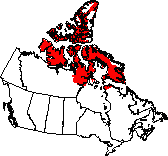|
Location
| Climate | Geology and geography
| Flora and fauna | Humans | Images
Location
Most of the archipelago north of Nunavut and the Northwest Territories
are included in the Northern Arctic.
Climate
Extending over most of the arctic islands, this is the coldest and driest
part of the country. Winter nights last for days or even months, and
average annual temperature is as low as -3║C in the northerly part of
the region. Precipitation is so low here, only 100 to 200mm a year,
that the region can be classified as an arctic desert. July and August
are the only months in which snow doesn't usually lie on the ground.
Permafrost, perpetually frozen ground, is present everywhere in this
ecozone and can extend downwards for over a kilometre. Only a thin layer
at the surface thaws during summer. The waters in the northern half
of the Northern Arctic are permanently frozen, but the southern waters
can be open in the summer, although ice still persists offshore throughout
the year.
Geology
and Geography
 The
western section of the ecozone consists of Palaeozoic and Mesozoic sedimentary
rock. Towards the east, the bedrock is mostly Precambrian granite. Most
of the Northern Arctic is flat or slightly rolling terrain. The west
is littered with glacial deposits and shattered limestone. Plains may
extend for several kilometres inland from the coast; once underwater,
these plains are now rising as the continent rises after having been
pushed down by glaciers during previous ice ages. The east is characterized
by plateaus and rocky hills, which eventually lead to the Arctic Cordillera
ecozone's mountains. The
western section of the ecozone consists of Palaeozoic and Mesozoic sedimentary
rock. Towards the east, the bedrock is mostly Precambrian granite. Most
of the Northern Arctic is flat or slightly rolling terrain. The west
is littered with glacial deposits and shattered limestone. Plains may
extend for several kilometres inland from the coast; once underwater,
these plains are now rising as the continent rises after having been
pushed down by glaciers during previous ice ages. The east is characterized
by plateaus and rocky hills, which eventually lead to the Arctic Cordillera
ecozone's mountains.
Flora
and Fauna
Plants
The entirety of the Northern Arctic lies above the tree line, so no
full-sized tree species can be found here. Very few plant species can
survive in these conditions. Plants are generally stunted and become
more so to the north.
Some plants found here include
purple saxifrage, mountain avens, arctic poppy, arctic willow, Dryas
species, kobresia, sedges, cottongrass, moss, dwarf birch, northern
Labrador tea, Vaccinium species, alder, alpine foxtail, wood rush, wire
rush, moss campions, white arctic heather, arctic bladder campion, yellow
oxytrope, mastodon flower, arctic lousewort, mountain sorrel, pygmy
buttercup, river beauty, chickweed.
Animals
Mammals
Only about twenty mammal species live here. The largest are the carnivorous
polar bear,
and arctic
wolf and the herbivourous barren-land
caribou and muskox.
The smaller carnivores found here include arctic
fox, ermine,
and wolverine,
while smaller herbivores include the snowshoe
hare, arctic
hare, brown
lemming and collared
lemming. Aquatic mammals that live in the waters off the coast include
walrus,
ringed seals,
bearded seals,
beluga,
narwhal,
and various other whales.
Birds
Most of the bird species migrate to the Northern Arctic in spring to
mate, leaving in fall. Birds of prey that can be found in the northern
arctic include gyrfalcon,
rough-legged
hawk, and snowy
owl. Waterfowl include snow
goose, brant,
Canada goose,
eider, oldsquaw
duck, red-throated
loon, arctic
loon and king
eider. Shorebirds and seabirds include the red
phalarope, parasitic
jaeger, red
knot, dunlin,
long-tailed jaeger,
northern fulmar,
glaucous gull,
white-rumped sandpiper,
black-bellied
plover, and ruddy
turnstone. Some forest birds of the ecozone are the willow
ptarmigan, rock
ptarmigan, hoary
redpoll, snow
bunting, lapland
longspur, and horned lark.
Amphibians and Reptiles
No reptiles or amphibians can survive the conditions here.
Humans
Approximately 15 000 people live in the Northern Arctic, and the majority
of the population is Inuit. Most people live through subsistence activities,
such as hunting, trapping and fishing, though gas and oil exploration
also provide a living for some, as does tourism.
Images
A small arctic island
Spring melt
Polar Bear Pass, Bathurst Island
Ellesmere Island
Blowing snow
Arctic ice
Arctic landscape
Arctic sunset
 

|
|




 The
western section of the ecozone consists of Palaeozoic and Mesozoic sedimentary
rock. Towards the east, the bedrock is mostly Precambrian granite. Most
of the Northern Arctic is flat or slightly rolling terrain. The west
is littered with glacial deposits and shattered limestone. Plains may
extend for several kilometres inland from the coast; once underwater,
these plains are now rising as the continent rises after having been
pushed down by glaciers during previous ice ages. The east is characterized
by plateaus and rocky hills, which eventually lead to the Arctic Cordillera
ecozone's mountains.
The
western section of the ecozone consists of Palaeozoic and Mesozoic sedimentary
rock. Towards the east, the bedrock is mostly Precambrian granite. Most
of the Northern Arctic is flat or slightly rolling terrain. The west
is littered with glacial deposits and shattered limestone. Plains may
extend for several kilometres inland from the coast; once underwater,
these plains are now rising as the continent rises after having been
pushed down by glaciers during previous ice ages. The east is characterized
by plateaus and rocky hills, which eventually lead to the Arctic Cordillera
ecozone's mountains.